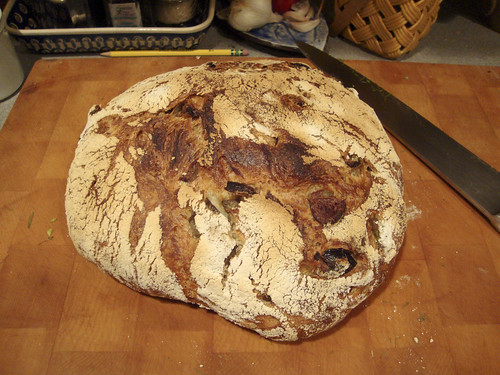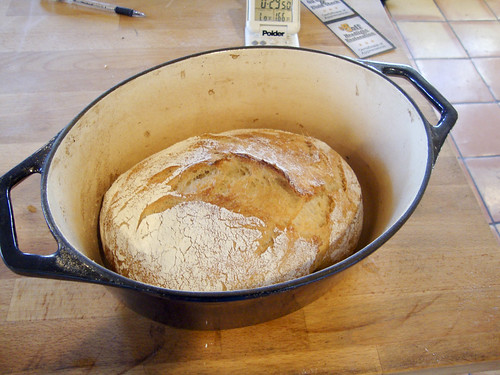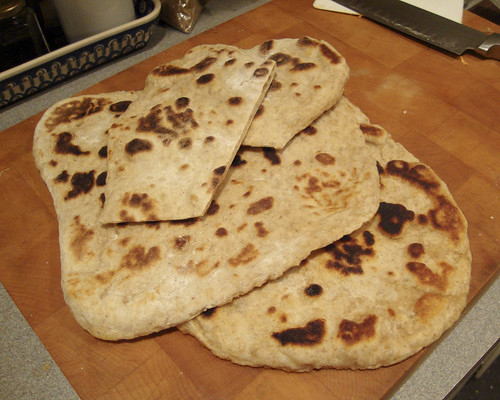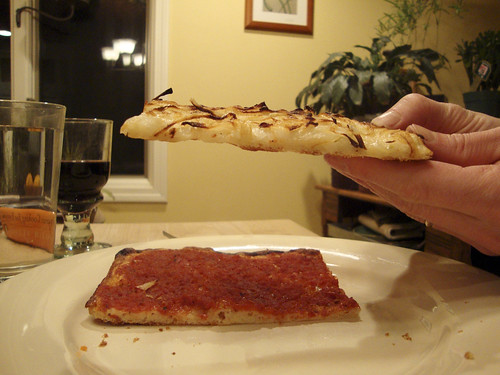 Jim Lahey is the owner of Sullivan Street Bakery in New York City. He opened the bakery in 1994 and has been spreading the love of great bread since then. Lahey's no-knead bread recipe achieved amazing popularity in blog circles in November 2006 when Mark Bittman published a story about this method in the New York Times.
Jim Lahey is the owner of Sullivan Street Bakery in New York City. He opened the bakery in 1994 and has been spreading the love of great bread since then. Lahey's no-knead bread recipe achieved amazing popularity in blog circles in November 2006 when Mark Bittman published a story about this method in the New York Times.Since then, several books have been published (not by Mr. Lahey) about the method. This past fall, Lahey finally published his book of recipes and techniques: My Bread. I'm not going to give you any recipes from the book, because I want you to go buy it. If you want to test-drive the recipes, follow the Bittman link for a basic recipe and method.
 My Bread has really revolutionized the way I'm baking bread these days. That basic principle behind this method is that of hands-off gluten formation. Gluten strength can be developed in one of two ways: by kneading the dough, or by letting the dough rest and letting the yeast do all the work. Letting the bread do the work for you makes a lot of sense.
My Bread has really revolutionized the way I'm baking bread these days. That basic principle behind this method is that of hands-off gluten formation. Gluten strength can be developed in one of two ways: by kneading the dough, or by letting the dough rest and letting the yeast do all the work. Letting the bread do the work for you makes a lot of sense.
 My Bread has really revolutionized the way I'm baking bread these days. That basic principle behind this method is that of hands-off gluten formation. Gluten strength can be developed in one of two ways: by kneading the dough, or by letting the dough rest and letting the yeast do all the work. Letting the bread do the work for you makes a lot of sense.
My Bread has really revolutionized the way I'm baking bread these days. That basic principle behind this method is that of hands-off gluten formation. Gluten strength can be developed in one of two ways: by kneading the dough, or by letting the dough rest and letting the yeast do all the work. Letting the bread do the work for you makes a lot of sense. Think about it: in ye olden tymes, back before the days of a Kitchenaid on every counter, people baked bread. Yes, they probably kneaded it by hand, but even with steady kneading the bread wouldn't have gotten worked over the way our modern mixers do it. Also, traditional baking relied on natural leavening which would have required longer rising times.


The no-knead method has one major disadvantage: it's not for the speedy baker. The dough really does need to work on its own. This means a minimum of 8-10 hours of rising time. But this also mean more flavor in the bread.
You don't need a lot of special equipment to make this bread. You do want a scale (but you should own one anyway) otherwise your results won't be consistent. Other than a scale, a big bowl, a rubber spatula and covered dutch oven are all you really need. Feel free to use this an excuse to buy a fancy Le Creuset or Emile Henry Dutch oven if you wish. I've done fine however, with a knockoff Dutch oven from Home Goods or Target, or a Lodge cast iron Dutch oven. You can also use a stainless pot with an oven-safe lid.
Now the breads (I'll be posting more pictures in this Flickr set as time goes by):
The glamour shot at the top of this post is rosemary-olive bread.
The bread in the pot is a wheat/white combo halfway through baking.

The sandwich loaf was made by gently folding the dough into a loaf shape and then placing it into a well greased loaf pan. This batch was over-proofed when it went into the oven: You can see that in the crappy oven spring (see how that slit in the top didn't really open up?). The flavor was still great and the bread made fabulous toast.

The flatbreads are made from the dough after its first rise. Take the dough, portion it into small balls (about 6 per recipe) and then roll them our into flat, tortilla-like discs. I baked them in a hot cast iron skillet. They bubbled up beautifully as you can see.
The pizza is made from a different recipe: it's much stiffer than the bread dough. It makes for a deliciously crisp-crusted pizza. You load the dough up with toppings, sliced super-thin and then blast the pizzas in a 500-degree oven. These are pictures of the tomato and onion pizzas.
Other no-knead bread posts from friends in the blogosphere
Steamy Kitchen: Jim Lahey's No-Knead Baguettes (Stecca)
Smitten Kitchen: No-Knead Bread





8 comments:
As a matter of sheer coincidence I'm heading to the bookstore to pick up this book, as well as Peter Reinhart's "The Bread Baker's Apprentice". I might grab "Healthy Bread in Five Minutes a Day".
I've been going crazy with bread lately; baking a load nearly every day since December.
Love the pizza information, as that's the next logical direction for my Lahey bread baking. Thank you for the shout out! Cheers, Cathy
I was just today considering buying one of the "five minute bread" books. There are at least two out there . . . how do these compare to "My Bread?"
HI Stefan, Eric and Cathy!
Boys - I like the Artisan bread in Five Minutes books too (Eric, the BBA is crazy-great, as I'm sure you've found out by now).
Stefan - I see the 5 min books and this one as good partners. Lahey's breads ares super crusty and need a dutch oven - the recipes are pretty much the same formula with a few ingredients swapped in and out. Not a strong-sounding endorsement, but I do love this book.
the 5 min series is friendlier and a little more accessible. There are some really great recipes in it, and they also focus on keeping that dough going in your fridge for up to a week - which Lahey does not focus on.
Ordered the book.
I'm going to start looking for a dutch oven at Goodwill.
Wow. WOW. I've been following this technique since it came out, and just checked Lahey's book out of the library. But something about your photos make it looks more revolutionary still. Need to get a batch of dough gluten-izing...
Here's an equipment question for those who have used this technique:
What sort of dutch oven should I go for?
There's a "camping style" which is really heavy cast metal, relatively small inside.
Then there's the enameled sort which Mary seems to be using.
I've seen the former type more often at thrift stores . . . or perhaps I really wasn't paying attention and didn't even notice the enameled type.
Stefan, Volume is really the issue here. Cast-iron or enameled will both work fine (enameled is just cast-iron with a fancy lining on it).
Ideally you want 4.5-5 qts capacity to have enough room for oven spring. I have used both enameled Dutch ovens and a deep cast iron skillet (the bottom calls it a chicken fryer) with another skillet turned over the top like a lid.
If the iron ones you're seeing are fairly shallow (like <3" you should be ok if they're wide (like 10" or so). And if you';re using a scale to measure your flour (you are right?), you can easily scale the recipe down by 25% or so to fit a smaller pot.
Post a Comment